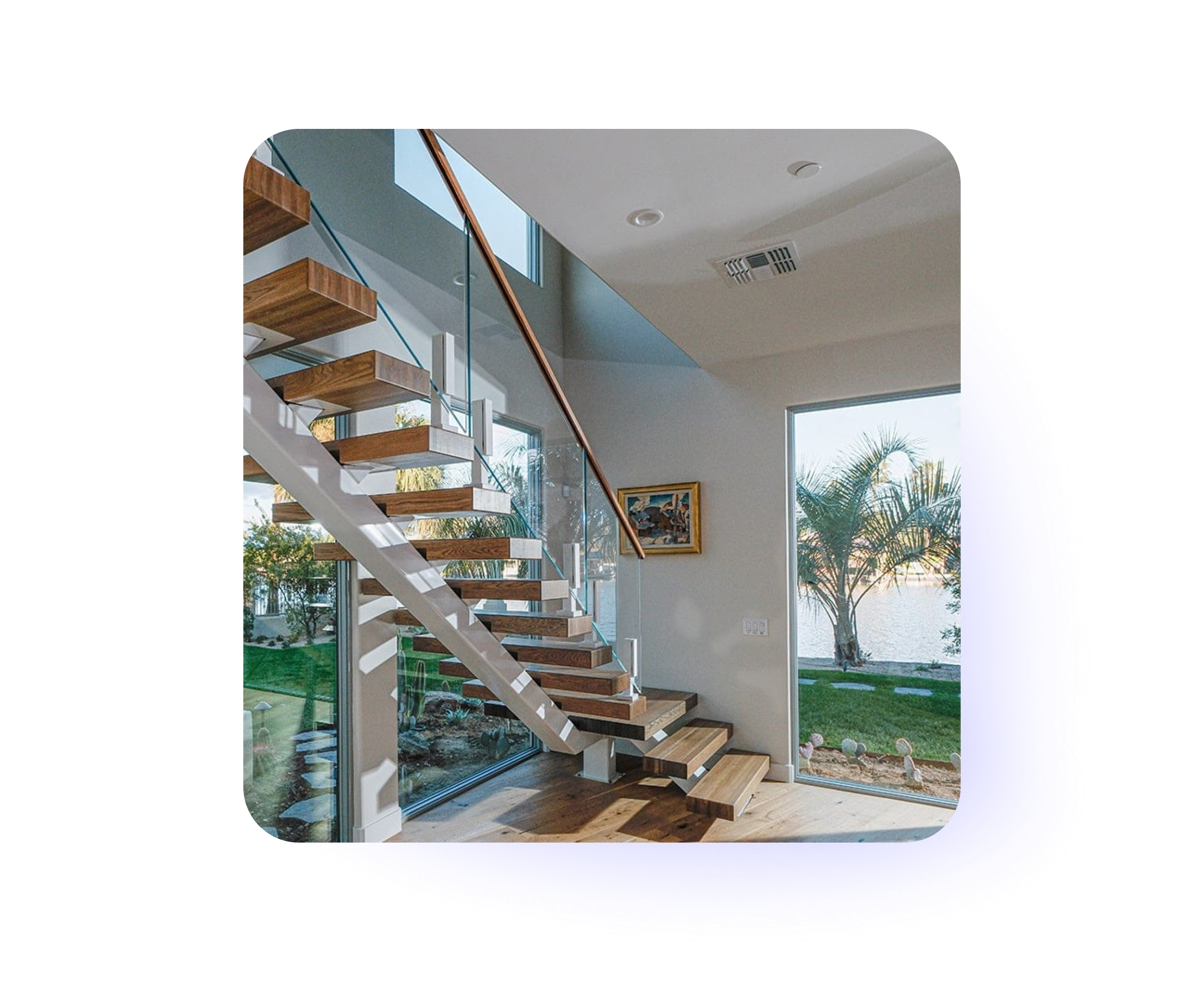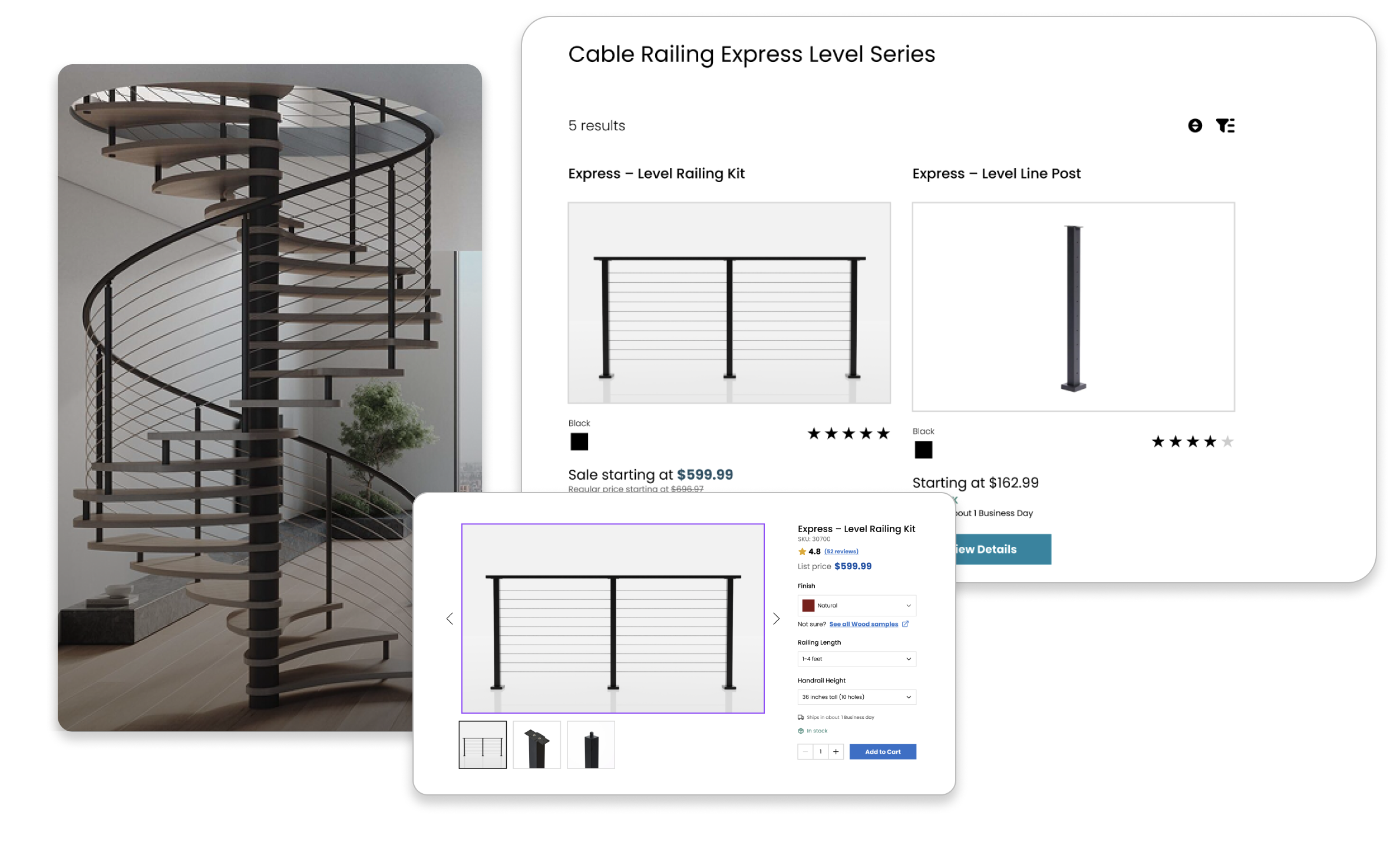


1
Goshen, Indiana, United States
Manufacturing
B2X
As a business offering modern staircases and railings, Viewrail experienced tremendous growth since 2018, as it focused on engineered-to-order solutions for large construction projects.
Despite the success and growth surrounding its FLIGHT stairs systems, the eCommerce side of the business targeting individual homeowners, DIY shoppers and smaller contractors took a hit. As Craig Glick Miller, Web Development Supervisor at Viewrail, said, “eCommerce once made up a third of our revenue, but as we grew, more focus shifted to inside sales and complex, engineered-to-order projects. The big question became: How do we expand in the D2C space and reclaim eCommerce momentum?”
This renewed focus on D2C eCommerce emerged due to increasing competition and knockoff alternatives. Viewrail needed to strengthen its digital footprint and shift the balance of its business model.
However, legacy technology was holding them back. Their aging WooCommerce platform, initially successful in the early 2010s, was no longer fit for purpose. Over time, the platform became a bottleneck, plagued by slow performance, limited flexibility and a lack of integration with internal systems that snowballed into intense manual labor and inefficient processes impacting the company’s financial results.
For instance, the growing complexity of Viewrail’s product catalog with thousands of SKUs per product due to custom dimensions, materials, finishes and combinations made basic updates time-consuming and error-prone as they were manually managed. “With thousands of product variations and constant design updates, it was nearly impossible for our small marketing team to keep up,” explained Joel Moyer, Search Engine Marketing Expert.
The lack of synchronization between their eCommerce sites and an ERP system meant that even routine updates, like adjusting pricing, required duplicated effort across multiple systems. Promotions were difficult to manage, product content updates online lagged behind product development, and customers were often routed into the slower, quote-driven sales process, undermining the potential of self-service D2C sales.
Viewrail also faced significant UX and brand challenges. With three distinct storefronts — StairSupplies, Schafer Floors and Viewrail — operating on disconnected systems, customer journeys lacked cohesion. Navigation was inconsistent, site speed varied dramatically and the experience fell short of what modern digital buyers expect.
To unlock greater agility, scalability and long-term growth, Viewrail chose to adopt a composable commerce platform. After evaluating several options, the team selected commercetools as its core commerce engine, attracted by its MACH®-based flexibility and ability to support both current needs and future expansion across multiple brands. “With commercetools, we can power one site or 100 from a shared backend,” explained Kyle Klimek, Chief Digital Officer at Viewrail. “We want to launch more D2C brands, so that flexibility to scale brands and storefronts without duplicating systems is what sealed the deal.”
Recognizing the need for implementation speed and cost efficiency, Viewrail partnered with Apply Digital to accelerate the build using its CAFE Accelerator and commercetools Foundry for B2B Manufacturing. The team launched an MVP in just 3.5 months — just in time for the 2025 spring peak season — focusing initially on cable railing products and core features. “We didn’t need a perfect button; we needed a practical one. Foundry gave us a ‘storefront-in-a-box’ approach that helped us modernize quickly and iterate over time,” added Craig.
A lean team drove the implementation and began with a focused discovery phase during the 2024 holiday downtime. Starting in January, Viewrail launched an MVP (minimum viable product) solution in mid-April 2025. The composable setup allowed Viewrail to prioritize critical functions — like ERP integration and unified navigation — while planning ongoing improvements and expansion. Using both commercetools Foundry and Apply Digital’s CAFE, Viewrail cut down development time by 50%.
Even in its early stages, the manufacturer’s new platform has shown strong performance improvements, faster load times and clear SEO benefits, while setting the foundation for long-term digital growth. “We’re already seeing speed gains, stability and success. Compared to our old WooCommerce setup, I’d say we’re running at least twice as fast,” said Craig.
If we hadn’t used commercetools Foundry for B2B Manufacturing, it would have taken considerably longer for us to build everything on the website from scratch or even build it off different accelerators or frameworks. We saved a ton of time and effort — and had immediate results.
Chief Digital Officer, Viewrail

By adopting a unified commerce platform at its core, Viewrail has unlocked the flexibility to scale across multiple brands, storefronts and customer segments — all from a single backend. “Everything being connected in one commercetools foundation means we can launch new sites, extend the catalog and update product pages across brands without duplicating effort,” explained Kyle.
For instance, Viewrail’s two biggest D2C sales peaks, Memorial Day and Black Friday, are when the company offers a 15-20% discount on all products sold via the online channel. With a scalable solution that increases capacity to meet customer demand, the company can now fully monetize those big shopping moments.
SEO has also been at the forefront of Viewrail’s plans. Before migrating to commercetools, SEO results had slipped, compromising brand visibility and lead generation. With a composable engine behind the scenes, the company enabled faster online experiences and UX improvements. This flexible infrastructure also enabled quicker iteration cycles, enabling teams to implement SEO-optimized content and components much faster.
By reacting to trends and user behavior in near real time, Viewrail increased organic clicks in the first week post-launch by +5-7% and jumped 5 spots in search rankings for “Cable Railing,” reaching the top 3 position for a key term.
More than search visibility, this agility and a flexible platform built for long-term scalability gave Viewrail the technical foundation it needed.
Looking ahead, Viewrail is working to unify its entire brand portfolio on commercetools, streamline content and product experiences and prepare to launch new brands in the future.
“We’re building toward a future where product updates, storefront launches and even retail integrations can happen without tech bottlenecks,” said Craig. “For example, we just opened our first showroom in New York City. What does that mean for eCommerce? Nothing right now, but someday we may have retail happen in that showroom. And how do we facilitate that? commercetools gives us the backend to plug this channel when we’re ready. That’s the value: Having this flexible foundation we can leverage as the business evolves.”

Discover our possibilities
for enterprise businessesDiscover our possibilities
for D2CDiscover
Why commercetools